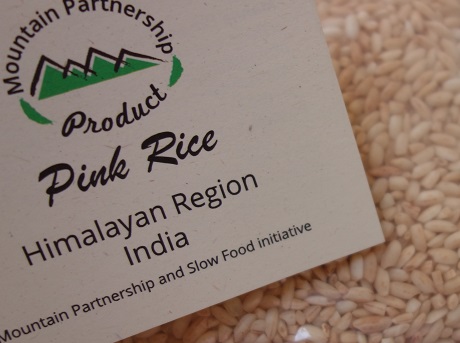 | Pink RiceRi Bhoi watershed, India |
Pink rice is an indigenous crop cultivated by small-scale women farmers in the Indian Himalayas. Believed to be the ancestor of white rice varieties, pink rice is rich in cultural and nutritional value. It is an integral part of local culture for the Bhoi, Garo, Jaintia and Khasi tribes who use the rice for traditional celebrations and ceremonies. For example, the Bhoi wrap pink rice in banana leaves when a newly wedded bride visits the groom’s family for the first time as a symbol of building a new family relationship.
Production
Pink rice is cultivated by tribal families through traditional farming systems and permaculture, without the use of chemical fertilizers. In order to adhere to local culture, it must be grown in jhum fields or paddy fields. Production lasts one year. Once the rice grains have been harvested, the entire plant is left in the field for 12 months. After that, it is turned into the soil and rice seedlings are transplanted by hand during the monsoon season.
Territory
This pink rice is farmed in the Indian Himalayas in the Ri Bhoi watershed, Meghalaya State at 1 200 - 1 800 metres above sea level.
Consumption
Easy to cook, tasty and colourful, pink rice is also used to make pudoh (rice cake with meat), pukhleiñ (fried rice cake) and sweet puddings as it gets creamy when overcooked and combines well with dairy and coconut milk.
Producer
Mahila Umang Producers Company is a collective of self-help groups and producers promoting sustainable livelihoods through the establishment of micro-enterprises. Producers run the enterprises following fair trade, ecologic, economic and equitable principles. More than 100 women farmers in the Ri Bhoi watershed, Meghalaya are involved in the cultivation of pink rice.
Further information